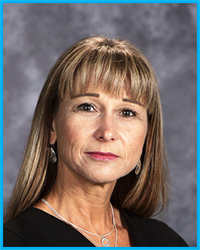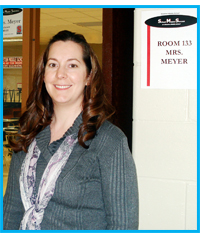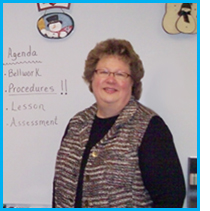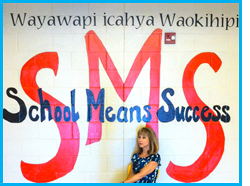
Karen and her teachers created a |
|
Effective Teaching...
by Harry and Rosemary Wong |
To print: Select File and then Print from your browser's menu ------------------------------------------------------------------ This article was printed from Teachers.Net Gazette, located at https://teachers.net. ------------------------------------------------------------------ |
Where Going to School Means Success.
 |
|||
|---|---|---|---|
|
Often times we will devote consecutive columns to an effective school in the hopes of clearly painting a picture of what’s happening in the school building that causes them to be so successful.
But, we’ve never revisited a school—until this month.
We began the school year 2011-2012 with the story of Sisseton Middle School (SMS) and will close out the school year with how the staff’s dedicated efforts have paid off for the students.
During this school year, the school was notified that they had received Adequate Yearly Progress (AYP)—for the first time ever at the school. This was accomplished in two years and they credit their Culture of Consistency as the vehicle for making this happen.
A Teacher of Teachers
 The principal of SMS, Karen Whitney, says, “At Sisseton Middle School, everyone works together in a consistent culture to help students make progress. I am truly grateful for the teachers I work with every day. My teachers deserve all of the credit for working as a team to create the consistency we needed to make procedures work.”
The principal of SMS, Karen Whitney, says, “At Sisseton Middle School, everyone works together in a consistent culture to help students make progress. I am truly grateful for the teachers I work with every day. My teachers deserve all of the credit for working as a team to create the consistency we needed to make procedures work.”
But the creation of a Culture of Consistency did not exist when Karen Whitney arrived at SMS four years ago. After analyzing the environment of her school, she realized the work that needed to be done so the students could experience success. Rather than telling teachers what to do, Karen became a “teacher of teachers” as she modeled techniques and expectations for her teachers.
She knew she had to develop consistency—predictability, reliability, and stability—for her students. And she knew she had to create the time needed for her teachers to be effective teachers. The most logical way to start was with procedures and she used The First Days of School as her guide.
To help the teachers implement their procedures, Karen created
the teachers could use for self-assessment and that Karen could use for formative assessment when she observed each teacher.
Everyone On the Same Page
Procedures were implemented schoolwide. Teachers new to the school had personalized instruction on procedures from Karen to get them up to speed before the rest of the staff returned to school. Procedures are seamlessly implemented by any teacher new to the staff. The veteran teachers found that procedures allowed them to be even more effective in the classroom.
A Preservice Teacher Is Amazed
 Tammy Meyer, a science teacher at SMS, had a preservice teacher observe her classroom. This was his first official classroom observation. Tammy opened the classroom to him and encouraged him to monitor students, watch the day's activities, and help with the lab activities that each class was participating in that day.
Tammy Meyer, a science teacher at SMS, had a preservice teacher observe her classroom. This was his first official classroom observation. Tammy opened the classroom to him and encouraged him to monitor students, watch the day's activities, and help with the lab activities that each class was participating in that day.
The following day, Tammy greeted him and asked, “So, what do you think of this whole business of becoming a teacher?”
She was not prepared for his response. He thought for a minute and then calmly replied, “There isn't the stress involved with teaching like I thought there would be.” Tammy asked him what he was expecting to see in the classroom. His response? “I expected there to be more conflict, argument, and chaos. That's what I remember from middle school and I expected to see it here. There just weren't any of those things in your classroom!”
Tammy shared with him that she teaches classroom procedures the first week of the school year. She tells the students everything they need to know, right down to the dreaded—what to do if you think you'll be sick in the middle of class. Nothing is left to chance. She has a plan and a procedure for everything that happens in their classroom.
Tammy says, “The students know exactly what to do when they walk into my classroom. There is no chaos, because they KNOW the procedures. When a new student comes into my classroom, I don't even have to explain the bellwork procedure—the other students model it so perfectly, the new student has no problem following along. There is no conflict, simply because I do not allow it. I want each student to know they're welcome to stay in the classroom as long as they don't cause a problem for anyone else, including me.
“These procedures carry over to my lesson planning. When putting together my lesson plans, I look at three things:
“The other middle school science teachers and I spent a summer laying out our curriculum for each grade level. We worked with what our state had already established, but made it into a working document we revisit weekly. In writing this working document, we established what we need to do in the classroom. Our standard is identified. Our goal is identified. The Bloom's level and appropriate skills are identified. The weekly lesson plans just lay out where we are in the yearly curriculum.
“I was at a conference the other week, and my sub left this note for me—‘All in all a great day! I expected middle school to be more stressful!!’ What wonderful words to read as I came back to my classroom—all because of consistency!”
What Is Consistency?
All schools and classrooms that are effective have a Culture of Consistency, a structure and organization of how the school and the classroom are run. Consistency refers to the sureness that things will happen with regularity and constancy.
Ineffective schools do not have a culture of consistency. The teachers work in isolation. They believe that programs, structural changes, money, philosophies, and ideologies will improve their school. So they keep looking for the silver bullet that will transform their school, when the silver bullet is right under their noses. It’s the teacher and the practices and procedures used by the teacher that create student learning and achievement.
When people experience a store as “a disappointing shopping experience,” they are describing a store that has no consistency. You do not like to shop at, dine at, or fly on businesses, restaurants, and airlines that are not consistent. You never know what’s going to happen TO YOU.
When you buy your favorite ice cream, you expect the ice cream to have the same quality and flavor you are used to. You buy the ice cream because it is consistent. You know what you’re going to get scoop after scoop, lick after lick.
SMS has created a Culture of Consistency and the students like the consistency. They thrive and learn more in a school that is consistent.
Students do not like to come to schools and classrooms that have no consistency. With the instability in the local and world economy, home life is fragile with many students coming from a dysfunctional environment. For six to seven hours each day, students want a sanctuary of hope, care, stability, and consistency. They do not want daily surprises that happen TO THEM.
Students do not want people yelling at them and being accused of “not knowing what to do” when it is so easy to teach procedures, which is “what to do.”
When you teach procedures you teach students “how to do things” which is a precursor to success in life.
Effective teachers have a classroom that is organized, structured, and CONSISTENT with a plan in how the classroom is run so the students will consistently know what to do to learn and succeed.
In a school and classroom that is consistent, the students know
what to do, when to do it, and how to do it.
With consistency, a teacher has taught responsibility,
and when students become responsible learners
they have the greatest opportunity to succeed.
How to Create Consistency
At SMS there is a set of ORGANIZED PROCEDURES and
a COHERENT LESSON PLAN format.
No one likes surprises. Everyone likes a classroom that is predictable and consistent. An organized classroom with procedures is a consistent classroom.
In a well-managed classroom, the students make better achievement gains in a class that begins in a predictable manner. For instance,
 Deb Thompson, a math teacher of 34 years says, “From the moment my students enter the classroom, they know what we will be doing and how we will be doing it. The Agenda with the Content Standard, bellwork, and the day's objective are posted every day in the front of the room. They know what I expect of them before I begin teaching the lesson. My instructional strategies, guided and independent practice, and daily assessment are all executed in the same way every day. My daily lessons and assessments come from the Achievement Series, an assessment system aligned to the South Dakota content standards.
Deb Thompson, a math teacher of 34 years says, “From the moment my students enter the classroom, they know what we will be doing and how we will be doing it. The Agenda with the Content Standard, bellwork, and the day's objective are posted every day in the front of the room. They know what I expect of them before I begin teaching the lesson. My instructional strategies, guided and independent practice, and daily assessment are all executed in the same way every day. My daily lessons and assessments come from the Achievement Series, an assessment system aligned to the South Dakota content standards.
“Sisseton Middle School is in its 2nd year of changes—for the better. We are a culture of consistency! Our teachers and paraprofessionals follow the same procedures throughout the day, from greeting our students at the door as they enter the classroom, to being at the door again as they leave the classroom with a friendly “Have a nice day,” “Good work,” or something similar.
“This is my 34th year of teaching, and I can honestly say last school year and this school year have been the most rewarding. I am so grateful that our principal, Mrs. Karen Whitney, believed in our staff and trusted that we could come together as a team for our students.”
All good schools have a vision or belief of creating STUDENT SUCCESS. When a Culture of Consistency is established, increased time for instruction and learning is created and the result is improved student achievement.
From Chaos to Calm
 Carrisa Metz, language arts teacher and team leader remarks, “Consistency with classroom procedures has had a huge impact on our school and everyone in it. The culture of our school has made a complete turnaround in the last two years. There used to be chaos around every corner!
Carrisa Metz, language arts teacher and team leader remarks, “Consistency with classroom procedures has had a huge impact on our school and everyone in it. The culture of our school has made a complete turnaround in the last two years. There used to be chaos around every corner!
Expectations were different from hallway to hallway and classroom to classroom. We are still far from perfection, but there now seems to be a calm and focus in our school. Students know what to expect and teachers know where to set their expectations. The most exciting part is that we have seen the most growth from our at-risk, EBD, and Native American students. Behavior has improved and test scores right along with it!”
In addition to the implementation of procedures that form the classroom management plan, all teachers at SMS use the same lesson plan format. This makes life easier for the students and the teachers, as the teachers know what to teach and the students know what to learn. Everyone knows what to do, what is happening, and what to expect—even the parents! When there is a culture of consistency, the students will work, produce, learn, and achieve.
Just as Karen created a first day script and rubric, she created a standard Lesson Plan Format with six items (including bellwork) that results in a coherent curriculum. All of the teachers use the lesson plan format and the students are exposed to it consistently. (Karen and the staff have tweaked the plan each year.)
Karen instructed the staff in each of the items that go into an effective lesson plan. Then she created a sample lesson plan for history and modeled how to go through the lesson planning process.
Bellwork is usually the same every day for every teacher. That remains constant so students know exactly what to do every day as they enter each teacher's classroom.
Then she put all six items plus the bellwork into a Lesson Plan Template so the teachers would find it easier to have an organized and coherent plan and be able to “fill in the blanks.” To see an 8th grade math lesson plan based on the school’s template that Deb Thompson created, click here.
Each Friday, every teacher electronically submits the lesson plan for the week.
Karen gives personal assistance to teachers who need help to jump start the lesson plan template process as well. All lesson plans are kept in binders in the school office. All teachers and parents have access to all lesson plans. This also helps teachers who need examples of good lesson plans. This is one of the ways newly hired teachers flow seamlessly into the consistent culture of SMS.
With a consistent classroom management plan and a consistent lesson plan format in place, the curriculum can be taught. Otherwise, time is wasted and energy expended putting out fires and dealing with behavior problems. The teachers, students, administration, and parents love a school that is safe, predictable, consistent, and nurturing. Research shows that providing such an environment for students will increase their achievement.
(Additional information on how to write lesson objectives and assessment rubrics, is found in Unit D in The First Days of School.)
Assessment for Student Progress
To help students succeed as they progress through the lesson plan and for teachers to constantly check for understanding so they can adjust their instruction, rubrics are regularly being developed by the teams at SMS.
Carrisa Metz continues, “Sisseton Middle School has come together as a collaborative team under the leadership of a principal.
“Deciding to move to a curriculum based on the Common Core Standards has been a very natural move for us. We spent the last year looking at our curriculum with a critical eye and really questioning what meets the standard and at what level of thinking. Even though we made modest improvements last year on our standardized test scores, we knew it wasn’t enough. There were still students that were not achieving to their full potential. Focusing on weak areas in our curriculum was a natural place to start and a natural place to start implementing Common Core Standards.
“This approach to teaching and standards would not have been possible without Mrs. Whitney’s brave instructions to put textbooks aside. What a scary moment that was for some of our teachers!
“The idea was to design a curriculum map based on the standards, evaluate what that looked like at the correct level of instruction and mastery, and then find lessons and assessments to fit the expectations. Now we truly do have a curriculum based on standards and not textbooks.
“Combining a formal lesson plan with
an aligned rubric is a very powerful tool for student success.”
Carissa Metz and her team have developed some rubrics to share with others.
Schools Exist for One Reason Only
The success of Sisseton Middle School can be attributed to Karen’s “stubborn persistence” that if there was to be a transformation in a low-performing school where Native American students and students from low-income families are to achieve at proficient or advance levels, having a school with schoolwide procedures and a common lesson plan format was not an option. It was and continues to be an expectation at SMS!
Karen’s leadership put in a place a process that produced results. Sisseton Middle School’s AYP achievement scored success for the students, the school, the district, and the community. With much pride, the stigma associated with all of the hindering attributes have been swept aside. Confidence has been created and opportunities are being dreamed.
 Karen graciously had this photo taken to put in our August column. The letters are giant sized and carry impact. Little did she realize that her vision School Means Success was about to be achieved. With the expectation set so vividly, students know their time will come.
Karen graciously had this photo taken to put in our August column. The letters are giant sized and carry impact. Little did she realize that her vision School Means Success was about to be achieved. With the expectation set so vividly, students know their time will come.
And that is what school is all about—Creating Success for All. If it can happen at SMS, it can happen in your school. Establish consistency in how your classroom runs and use a consistent format in your lesson delivery. You can create success for all of YOUR students.
© Harry K. Wong Publications, Inc. Permission to print and share with the profession is granted.